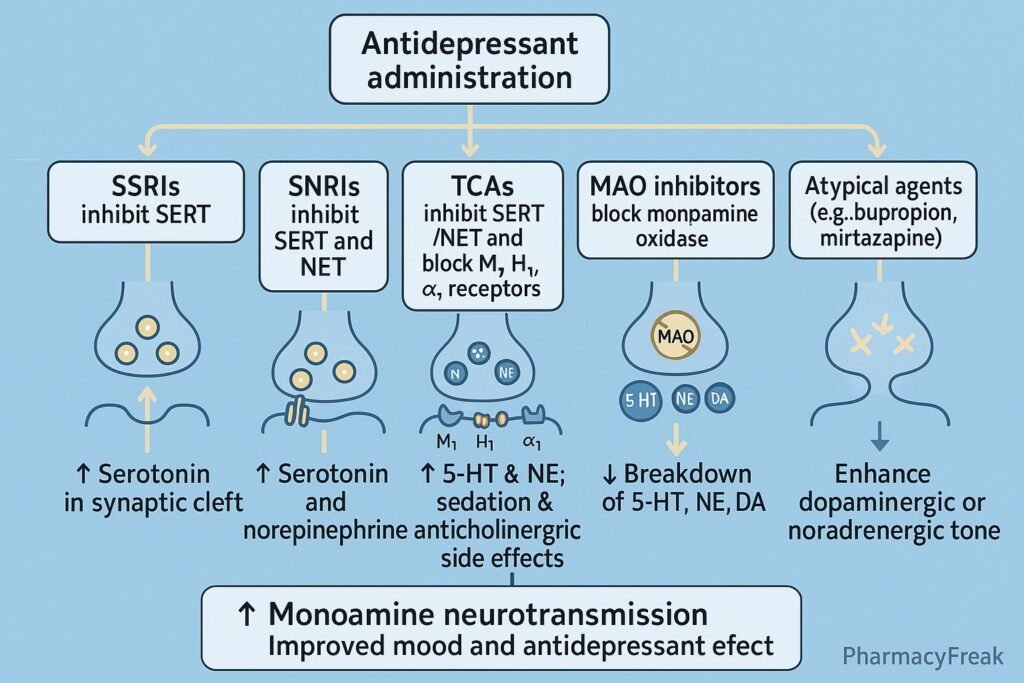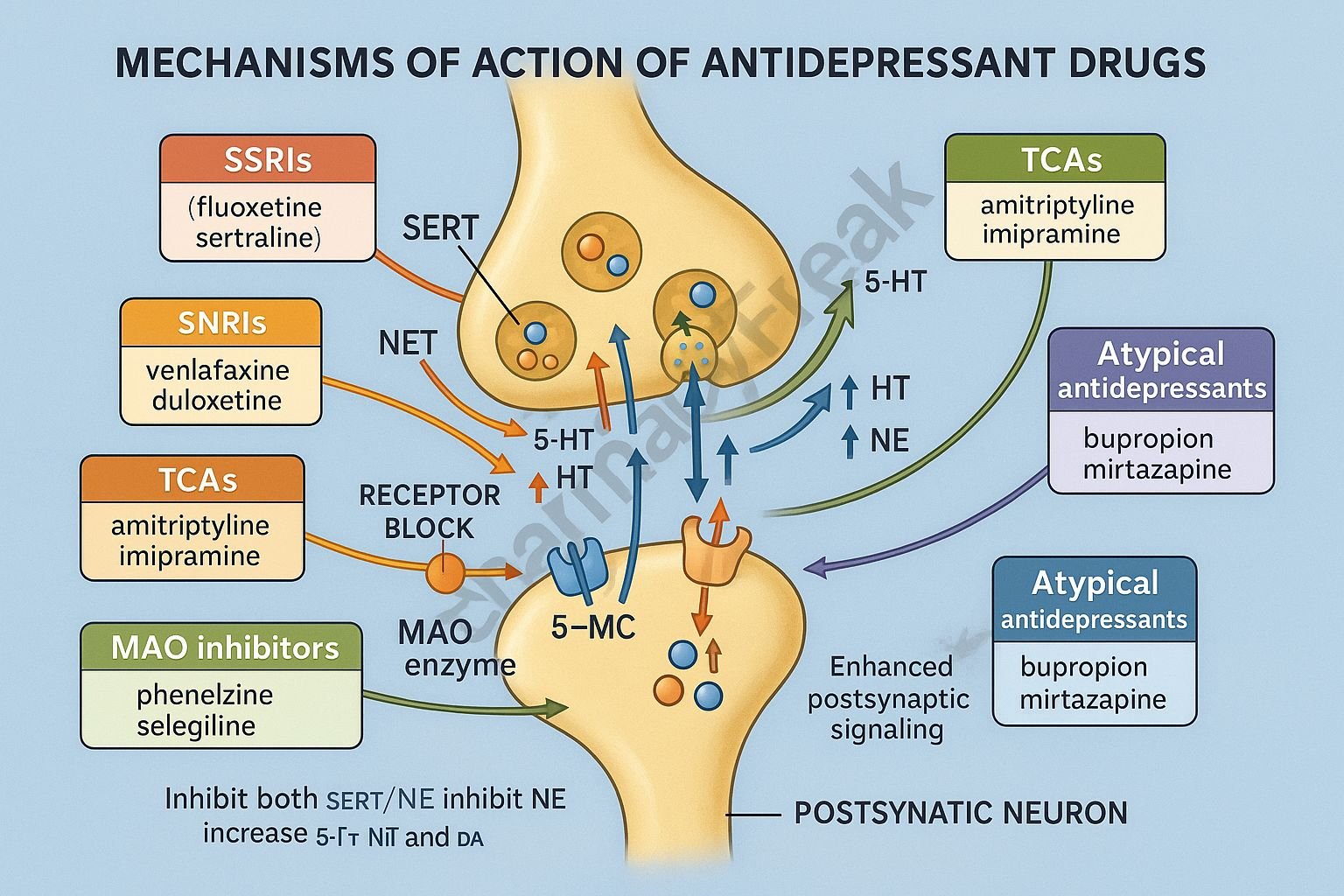Table of Contents
Introduction
Antidepressant drugs are psychotropic agents used to treat major depressive disorder, anxiety, OCD, PTSD, and chronic pain syndromes. Mechanism of Action of Antidepressant Drugs centers around increasing synaptic concentrations of monoamine neurotransmitters—primarily serotonin (5-HT), norepinephrine (NE), and dopamine (DA)—within the central nervous system. These drugs act on transporters, enzymes, or receptors to restore neurochemical balance and improve mood, sleep, and cognition.
Mechanism of Action (Step-wise)
Antidepressants work by altering neurotransmitter dynamics in key mood-regulating pathways, especially the limbic system and prefrontal cortex.

1. Inhibition of Monoamine Reuptake (SSRIs, SNRIs, TCAs)
- Mechanism:
- These drugs block the reuptake transporters for serotonin (SERT) and/or norepinephrine (NET), increasing neurotransmitter levels in the synaptic cleft.
- Classes and examples:
- SSRIs: Fluoxetine, Sertraline, Paroxetine, Escitalopram.
- SNRIs: Venlafaxine, Duloxetine, Desvenlafaxine.
- TCAs: Amitriptyline, Imipramine, Nortriptyline (block both SERT and NET, plus H₁ and M₁ receptors).
- Effect: Enhanced serotonergic and noradrenergic transmission → mood elevation and reduced anxiety.
2. Inhibition of Monoamine Oxidase (MAO Inhibitors)
- Mechanism:
- MAO enzymes degrade serotonin, norepinephrine, and dopamine.
- MAO inhibitors prevent this degradation, leading to increased intracellular and synaptic levels of monoamines.
- Examples:
- Phenelzine, Tranylcypromine, Selegiline.
- Effect: Increased neurotransmitter availability and prolonged signaling.
- Note: Risk of hypertensive crisis when combined with tyramine-rich foods or other serotonergic agents.
3. Blockade of Presynaptic Autoreceptors
- Mechanism:
- Some antidepressants (e.g., Mirtazapine) block α₂-adrenergic autoreceptors and 5-HT₂/5-HT₃ receptors, enhancing norepinephrine and serotonin release.
- Effect: Greater neurotransmitter release → improved mood with reduced anxiety and sexual side effects.
4. Modulation of Dopaminergic Pathways
- Mechanism:
- Certain agents (e.g., Bupropion) inhibit dopamine (DAT) and norepinephrine reuptake, boosting motivation and energy without significant sexual dysfunction.
- Effect: Useful in depression with fatigue or anhedonia and as adjunct therapy in smoking cessation.
5. Neurotrophic and Adaptive Effects
- Mechanism:
- Chronic antidepressant therapy increases brain-derived neurotrophic factor (BDNF), promoting neurogenesis and synaptic plasticity in the hippocampus.
- Effect: Restores neuronal resilience and long-term mood stabilization (delayed onset of full antidepressant effect).
Summary Table of Mechanisms
| Drug Class | Primary Mechanism | Key Neurotransmitters | Examples |
|---|---|---|---|
| SSRIs | Inhibit serotonin reuptake (SERT) | Serotonin | Fluoxetine, Sertraline |
| SNRIs | Inhibit serotonin and norepinephrine reuptake | 5-HT, NE | Venlafaxine, Duloxetine |
| TCAs | Inhibit SERT and NET + block H₁/M₁ receptors | 5-HT, NE | Amitriptyline, Imipramine |
| MAO Inhibitors | Inhibit monoamine oxidase enzyme | 5-HT, NE, DA | Phenelzine, Selegiline |
| Atypical (NaSSA, NDRI, etc.) | α₂, 5-HT₂/3 antagonism, or dopamine reuptake block | NE, 5-HT, DA | Mirtazapine, Bupropion |
MCQs
1. The main mechanism of SSRIs is:
a) Monoamine oxidase inhibition
b) Serotonin reuptake inhibition
c) Dopamine receptor blockade
d) Acetylcholine antagonism
Answer: b) Serotonin reuptake inhibition
2. Which antidepressant inhibits both serotonin and norepinephrine reuptake?
a) Fluoxetine
b) Venlafaxine
c) Bupropion
d) Mirtazapine
Answer: b) Venlafaxine
3. MAO inhibitors increase the levels of:
a) Only serotonin
b) Only norepinephrine
c) Serotonin, norepinephrine, and dopamine
d) Only dopamine
Answer: c) Serotonin, norepinephrine, and dopamine
4. Mirtazapine acts by:
a) Inhibiting serotonin reuptake
b) Blocking α₂ and 5-HT₂ receptors
c) Inhibiting MAO
d) Activating dopamine receptors
Answer: b) Blocking α₂ and 5-HT₂ receptors
5. Which antidepressant enhances dopamine transmission?
a) Bupropion
b) Fluoxetine
c) Amitriptyline
d) Phenelzine
Answer: a) Bupropion
6. The delayed onset of antidepressant effect is due to:
a) Immediate receptor blockade
b) Downregulation of presynaptic receptors and BDNF increase
c) Reduced monoamine storage
d) Decreased receptor sensitivity
Answer: b) Downregulation of presynaptic receptors and BDNF increase
7. Which antidepressant carries a risk of hypertensive crisis with tyramine?
a) Sertraline
b) Phenelzine
c) Duloxetine
d) Mirtazapine
Answer: b) Phenelzine
8. Which antidepressant class has the least sexual side effects?
a) SSRIs
b) MAO inhibitors
c) Atypical (Bupropion, Mirtazapine)
d) TCAs
Answer: c) Atypical (Bupropion, Mirtazapine)
9. Which neurotransmitter is primarily affected by SNRIs?
a) GABA
b) Serotonin and norepinephrine
c) Dopamine only
d) Acetylcholine
Answer: b) Serotonin and norepinephrine
10. TCAs have additional side effects due to:
a) Alpha-2 receptor activation
b) Blockade of H₁, M₁, and α₁ receptors
c) MAO inhibition
d) Increased dopamine release
Answer: b) Blockade of H₁, M₁, and α₁ receptors
FAQs
Q1. What is the primary action of antidepressants?
They enhance synaptic levels of serotonin, norepinephrine, or dopamine to correct mood dysregulation.
Q2. Why do antidepressants take weeks to work?
Because adaptive receptor and neuroplastic changes, such as BDNF upregulation, occur gradually.
Q3. Which class of antidepressants is most commonly prescribed?
SSRIs—due to safety, tolerability, and low overdose risk.
Q4. Can antidepressants cause serotonin syndrome?
Yes, especially when combined with other serotonergic drugs (e.g., MAOIs, triptans).
Q5. What antidepressant is preferred in patients with sexual dysfunction?
Bupropion, as it increases dopamine and lacks serotonergic sexual side effects.
Q6. Are antidepressants addictive?
No, they do not produce dependence or cravings but must be tapered to prevent withdrawal symptoms.
References
- Goodman & Gilman’s The Pharmacological Basis of Therapeutics
- Katzung’s Basic and Clinical Pharmacology
- Stahl’s Essential Psychopharmacology
- Harrison’s Principles of Internal Medicine
Related Internal Links

I am pursuing MBA in pharmaceutical management from NIPER Hyderabad with a strong academic record and proven success in national-level pharmacy entrance exams. I secured AIR 61 in NIPER 2024 (MS/M.Pharm) and AIR 27 in NIPER MBA, along with AIR 147 in GPAT 2024 and AIR 907 in GPAT 2023. I also achieved AIR 6 in AIIMS CRE-2025 for Drug Store Keeper and was selected as a Pharmacist (AIR 61) for ESIC. Additionally, I was the Runner-Up in Round 2 of the EY Case Study Competition.
At PharmacyFreak.com, I aim to guide future pharmacists through expert content, exam strategies, and insightful resources based on real experience and academic excellence.
Mail- harsh@pharmacyfreak.com
